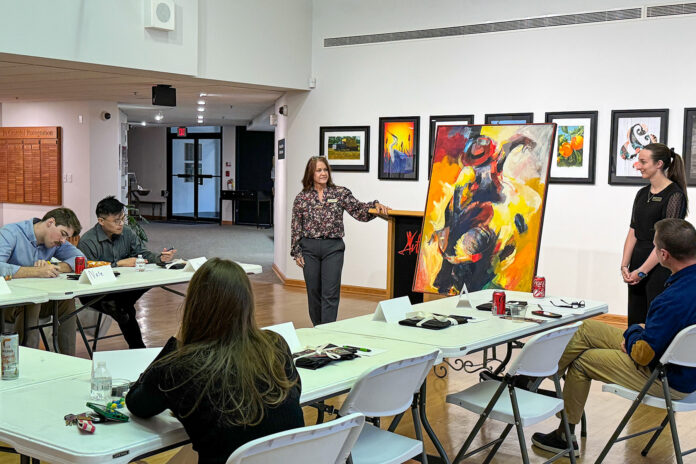
To help teach empathy, critical thinking and teamwork to future physicians, Mercer University School of Medicine professors turn to art.
All third-year medical students at Mercer participate in visualization training as part of the School of Medicine’s medical humanities curriculum. For the training, students visit an art gallery or exhibit, and an art historian leads them through observing and analyzing art both independently and together.
“What we hope that it does is sharpen the students’ visual observations of their patients,” said Dr. Brian Childs, professor and chair of the Department of Bioethics and Medical Humanities in the School of Medicine. “Rather than just looking at lab results or looking at radiographs, you look at people.”
The 1 ½-hour training sessions are offered through the Department of Bioethics and Medical Humanities at the beginning of the fall and spring semesters. They’re held at art museums in each of the four cities — Macon, Savannah, Columbus and Valdosta — where Mercer has a medical school campus.
“In medicine, we want students to see the importance of observing their patients outside of the medical questions that they’re required to ask,” said Dr. Caroline Anglim, assistant professor of bioethics and professionalism. “What is their patient wearing? Have they showered? Does it seem like they’ve been able to take care of themselves? Are they wearing things that may signify who they are beyond just their disease.”
These observations help doctors ask empathetic questions that aid in understanding the context of a person’s life and their ability to care for themselves or follow a treatment plan, she said.
“There are a lot of visual cues that can give physicians at least some indication of what the right questions are,” she said.
During the training, students are asked to observe a piece of art and point out details to each other. They learn the difference between observation and interpretation and why it’s important to not jump to interpretations when trying to make decisions in a group.
The training has been empirically tested, and studies have shown it increases physicians’ empathetic response to patients, Dr. Childs said.
Katie Cuadrado, a third-year medical student in Savannah, completed her visualization training in January at the Telfair Museums.
“They initially kind of just let us walk around. We were each given a little notebook where we could jot down thoughts, ideas, sketches. It was an independent activity,” she said. “Then we regrouped and went to paintings as a larger group, and we had a guide who gave us prompted questions to think about as we looked at each painting, trying to go beyond the surface of what we saw. We were given some time to think and then share our thoughts as a group about each piece of artwork.”
The activity was a fun and low stakes way for her and her classmates to practice their observation skills in a nonmedical setting, she said. For some students, especially those who may be more data-driven and science-inclined, learning soft skills of human connection and emotional interpretation can be challenging.
“I think this is a really great avenue to practice those skills and explore that side of your decision-making and problem-solving approach to patient care,” Cuadrado said.
Owen Phelps, a third-year medical student in Savannah, participated in the training session with Cuadrado. He said that when he started his rotations, he really began to see the value of the training.
He recalled looking at a painting that he initially saw as just a boat on the water. But as he observed and analyzed the piece, he began to see other details that he missed. When meeting with patients, those extra details could make a difference as to how he can best serve them.
“I realized that we do that often in medicine. We sort of label patients as their chief complaint,” he said. “And now that I’ve gone through rotations and looking back and reflecting on that experience and the visualization training, it’s about taking a look at a patient holistically and beyond their chief complaint.”
Mercer’s School of Medicine established the Department of Bioethics and Medical Humanities in 2021. Bioethics focuses on the moral and social aspects of medical policy and practice, while medical humanities integrates the humanities, social science and the arts into medical education.







